Application of Kinetic Study in the Preparation of Magnesium Hydroxide from Carbide Slag and Magnesium Chloride

As an important inorganic compound, magnesium hydroxide is widely used in many industrial fields. The use of carbide slag and magnesium chloride to prepare magnesium hydroxide through the ammonia method not only improves the recycling rate of resources, but also attracts much attention for its environmental protection characteristics. This article will explore the kinetic factors in this process and their impact on production efficiency.
Preparation principle
Carbide slag: The main component is calcium hydroxide (Ca(OH)₂), which can be used as a reactant source.
Magnesium chloride: extracted from salt lakes and reacts with ammonia water to form magnesium hydroxide precipitate.
Key factors in kinetic research
Reactant concentration: directly affects the reaction rate. The higher the concentration, the faster the reaction.
Reaction temperature: As the temperature rises, the molecular movement accelerates and the reaction rate increases.
Stirring speed: Ensure that the reactants are fully mixed and increase the reaction rate.
pH value: The control of pH value in the ammonia method is crucial to the formation of precipitation.
Precipitant type: affects the reaction kinetics.
Precipitate particle size: Small particles provide a larger reaction surface area and accelerate the reaction.
Kinetic model
A mathematical model, such as the first-order kinetic equation, is established to describe and predict the reaction process: r=k[Mg2+] where r is the reaction rate, k is the rate constant, and [Mg2+] is the magnesium ion concentration.
Experimental method
Reaction rate measurement: Determine the kinetic parameters by monitoring the consumption of reactants or the formation of products.
pH monitoring: Ensure the stability of reaction conditions.
Thermogravimetric analysis (TGA): Evaluate the thermal stability and mass loss of samples.
X-ray diffraction (XRD): Confirm the crystalline state of the product.
Scanning electron microscopy (SEM): Observe the microstructure and morphology of the product.
Conclusion
The process of preparing magnesium hydroxide from carbide slag and magnesium chloride can be optimized through kinetic studies, and the production efficiency and product quality can be improved. Understanding and controlling reaction conditions, such as concentration, temperature, pH value, etc., are of great significance to achieve efficient production.








